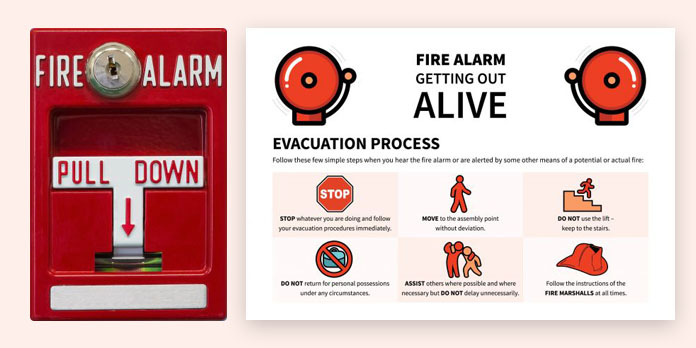Once the emergency plan has been developed and training given, you will need to evaluate its effectiveness. The best way to do this is to perform a fire drill. This should be carried out at least annually or as determined by your fire risk assessment. If you have a high staff turnover, you may need to carry them our more often.
A well-planned and executed fire drill will confirm understanding of the training and provide helpful information for future training. The responsible person should determine the possible objectives of the drill such as to:
* identify any weaknesses in the evacuation strategy;
* test the procedure following any recent alteration or changes to working practices;
* familiarise new members of staff with procedures, and
* test the arrangements for disabled people and young persons on work experience.
Who should take part?
Where a building has an excess of a single escape route, the evacuation plan must allow for the evacuation of occupants assuming one of the exit points or stairwells is not accessible due to fire or smoke. You could model this based on a nominated individual being situated along the escape route. If this is done on various drills and routes, occupants will be more likely to use routes that they would not normally take.
Premises that consist of several buildings on the same site, should be dealt with one building at a time over an appropriate period, unless the emergency procedure dictates otherwise.
Where appropriate, you may find it helpful to include members of the public in your fire drill – ensuring that all necessary health and safety issues are addressed before you do so.
Carrying out the drill
For premises that have more than one escape route, the escape plan should be designed to evacuate all people on the assumption that one exit or stairway is unavailable because of the fire. This could be simulated by a designated person being located at a suitable point on an exit route. Applying this scenario to different escape routes at each fire drill will encourage individuals to use alternative escape routes which they may not normally use.
When carrying out the drill you might find it helpful to:
* circulate details concerning the drill and inform all staff of their duty to participate. 'Unexpected drills' may be counterproductive in some cases due to other safety which may result.
* ensure that equipment can be safely left;
* nominate observers;
* inform the alarm receiving centre if the fire-warning system is monitored (if the fire and rescue service is normally called directly from your premises, ensure that this does not happen);
* inform visitors and members of the public if they are present;
* ask a member of staff at random to set off the alarm by operating the nearest alarm call point using the test key.
This will indicate the level of knowledge regarding the location of the nearest call point.
The roll call/checking the premises have been evacuated.
Carry out a roll call as soon as possible at the designated assembly point(s), and/or receive reports from wardens designated to ‘sweep’ the premises. You should note any people who are unaccounted for. In a real evacuation this information will need to be passed to the fire and rescue services on arrival.
Check that people have assembled at the evacuation point.
Once the roll call is complete or all reports have been received, allow people to return to the building. If the fire-warning system is monitored, inform the alarm receiving centre that the drill has now been completed and record the outcomes of the drill.
Monitoring and debrief
During any fire drill, the responsible person and other 'observers' should give specific attention to;
* communication difficulties with regard to the roll call and establishing that everyone is accounted for;
* the use of the nearest available escape routes as opposed to common circulation routes;
* difficulties experienced by people with disabilities;
* the roles of specified people, e.g. fire wardens;
* inappropriate actions, e.g. stopping to collect personal items attempting to use lifts etc; and
* windows and doors not being closed as people leave.
On-the-spot debriefs are useful to discuss the fire drill, encouraging feedback from everybody. Later, reports from fire wardens and observations from people should be collated and reviewed.
Any conclusions and remedial actions should be recorded and implemented.
 Loading... Please wait...
Loading... Please wait... Loading... Please wait...
Loading... Please wait...